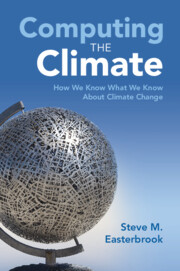Book contents
- Computing the Climate
- Epigraph
- Computing the Climate
- Copyright page
- Contents
- Preface
- Acknowledgements
- 1 Introduction
- 2 The World’s First Climate Model
- 3 The Forecast Factory
- 4 Taming Chaos
- 5 The Heart of the Machine
- 6 The Well-Equipped Physics Lab
- 7 Plug and Play
- 8 Sound Science
- 9 Choosing a Future
- References
- Index
4 - Taming Chaos
Published online by Cambridge University Press: 10 August 2023
- Computing the Climate
- Epigraph
- Computing the Climate
- Copyright page
- Contents
- Preface
- Acknowledgements
- 1 Introduction
- 2 The World’s First Climate Model
- 3 The Forecast Factory
- 4 Taming Chaos
- 5 The Heart of the Machine
- 6 The Well-Equipped Physics Lab
- 7 Plug and Play
- 8 Sound Science
- 9 Choosing a Future
- References
- Index
Summary
Climate models are often presented as tools to predict future climate change. But that’s more a reflection of the questions that politicians and the general public ask of the science, rather than what the science does. Climate scientists prefer to use their models to improve our understanding of the past and present, where more definitive answers are possible. Predicting the future is notoriously hard. It requires some careful thinking about what can be predicted and what cannot. On this question, early experiments with climate models led to one of the most profound scientific discoveries of the twentieth century – chaos theory – which gave us a new understanding of the limits of predictability of complex systems. The so-called butterfly effect of chaos theory helps explain why a computer model can predict the weather only for a few days in advance, while the same model can simulate a changing climate over decades and even millennia. To find out why, read on!
- Type
- Chapter
- Information
- Computing the ClimateHow We Know What We Know About Climate Change, pp. 90 - 120Publisher: Cambridge University PressPrint publication year: 2023

